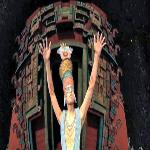May 20, 2011

From the film: "All Maya kept the same ritual, solar and long count calendars, using them to describe the past and foretell the future."
In recent years, the idea that the world will end on December 21, 2012 has gained attention and spawned thousands of web sites, blogs, books and even a Hollywood movie. Although scientists generally dismiss the idea, curators of the Museum of Natural Science in Houston decided to use the prediction as a hook to draw visitors into the world of the ancient Maya. They do it through a planetarium film and an exhibit being prepared for next year - just in time, some might say, for the end of everything.
The film shown on the museum's huge planetarium screen examines myths and rituals of the ancient Maya in southern Mexico and Central America. It focuses on the Maya calendar, or long count, which was divided into baktuns of 144,000 days each.
From the film: "All Maya kept the same ritual, solar and long count calendars, using them to describe the past and foretell the future."
On some surviving calendars, everything ends on the day equivalent to our date of December 21, 2012.
Carolyn Sumners, Vice President of the museum's Department of Astronomy and Physical Science, supervised the film project. "There is an alignment with the center of the galaxy on December 21st. It just happens that the Maya 13th Baktun starts on December 21st, at least in some of the calendars, and there is just enough going on to make one wonder if it is all connected," she said.
But the film makes clear that the Maya were not necessarily predicting catastrophe.
Sumners says the end of Maya time periods generally were regarded the same way we look at such things as the start of a new century or a new millennium. "It seems to be a cause of celebration. There does not seem to be any indication in the Maya writings of great disaster. They did believe in the end of time; they talked about great floods,
Sumners explained. "All these things were discussed, but they did not tie them to the long count."
To bring audiences into the world of the Maya, Sumners and her team went to four sites in Mexico and Guatemala to shoot extreme wide-angle video of the ruins.
They employed computer-generated images to show what those sites might have looked like centuries ago when they were the centers of great Maya achievements in math and astronomy.
Visitors to Houston's Natural Science Museum can also see Maya artifacts on display.
Curator Dirk Van Tuerenhout is developing an even larger exhibit for next year, to coincide with the end-of-world date. "It is a combination of all kinds of sources of information that we are pulling together to tell the story of the Maya culture, ancient Maya, colonial Maya, modern Maya," said Van Tuerenhout.
The Maya civilization collapsed more than 500 years ago, probably because of environmental changes that undermined its agriculture. But Maya people still live in the Yucatan peninsula and parts of Central America and many have emigrated to Houston.
Researchers have used their knowledge of modern Maya languages to decipher the ancient hieroglyphs, and many top experts in this field are at the University of Texas.
Van Tuerenhout says they offer valuable insights. "The ancient voices are speaking through these very few individuals who can read and decipher Maya writing," he said.
Van Tuerenhout says ancient Mayan sites continue to provide new information about the mysterious ancient civilization and its achievements.
He says the Museum's goal is to show people that there is much more to the Maya than a spurious prediction of doom.